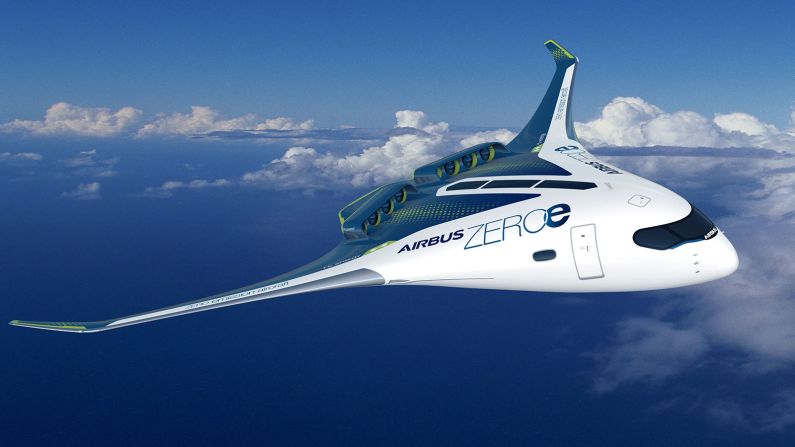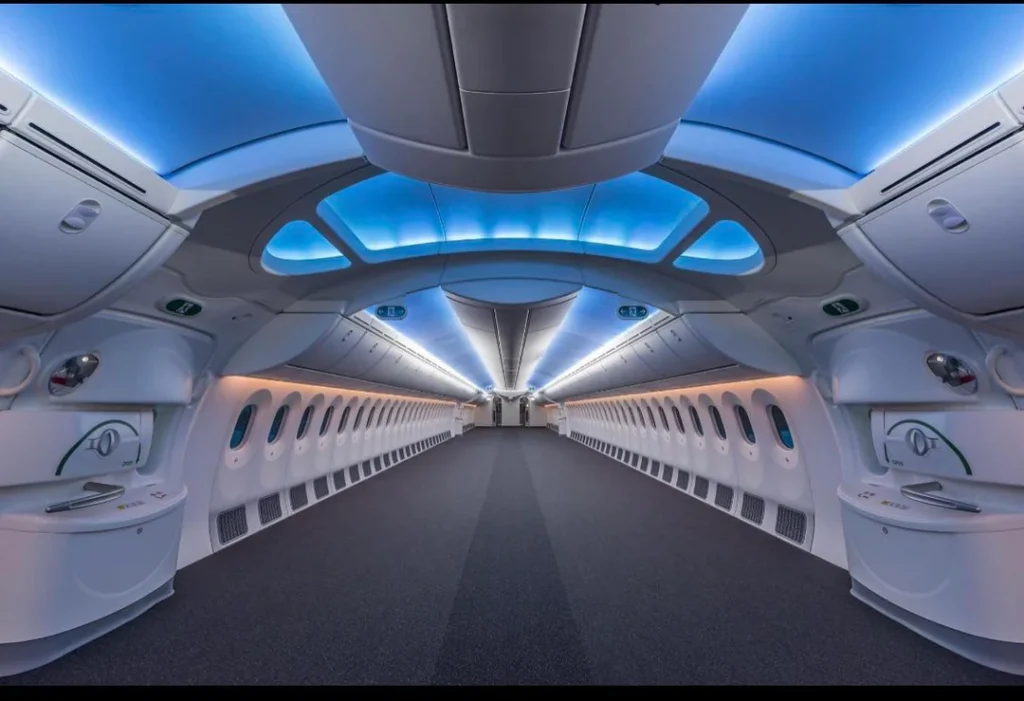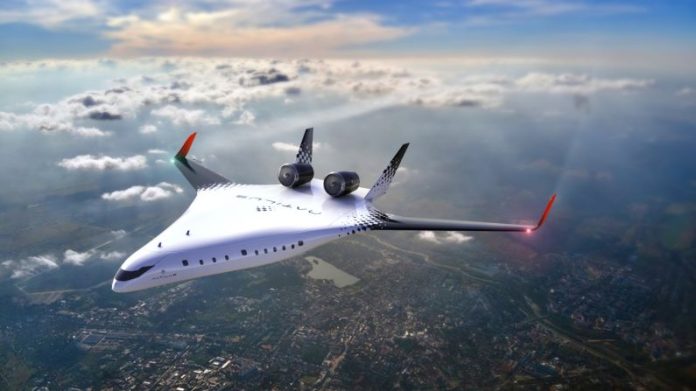Revolutionizing Air Travel: Natilus Unveils Plans for Horizon, a Game-Changing Blended Wing Airplane.
In response to soaring global demand for air travel and the corresponding rise in aviation emissions, innovative solutions are desperately needed to transform the industry. Traditional commercial air plane designs have been the standard for over a century, but new technologies and designs are emerging to challenge the status quo. Among these, the newly announced Horizon air plane by San Diego-based Natilus promises a paradigm shift in how we view modern air travel. This blended wing body design not only aims to significantly reduce fuel consumption but also aims to enhance the overall passenger experience.
Aviation has seen a rapid increase in emissions over the past few decades, outpacing reductions in other transportation sectors such as rail, road, and shipping. According to experts, Sustainable Aviation Fuel (SAF) has the potential to reduce aviation emissions by up to 80% when produced and utilized correctly. However, despite its promise, SAF remains in limited supply and is projected to constitute just 0.53% of all jet fuel use in 2024.
To achieve net-zero emissions by 2050, the aviation industry must innovate at an unprecedented rate. Airlines and regulators are scrambling to find ways to decarbonize air travel, and one promising avenue involves rethinking aircraft design. Traditional “tube and wing” aircraft could soon give way to designs like the blended wing body, which allows for a more aerodynamic shape and improved fuel efficiency.

Natilus has stepped into this uncharted territory with the announcement of the Horizon, a passenger air plane featuring a blended wing body design intended to carry approximately 200 passengers. The innovative design is anticipated to reduce emissions by half and cut fuel consumption by 30% compared to conventional aircraft such as the Boeing 737 and Airbus A320.
Aleksey Matyushev, CEO and co-founder of Natilus, asserts that the narrow-body market is poised for significant growth in the next 20 years, presenting an opportunity for the Horizon to disrupt existing models. “For the first time ever, I think there’s an opportunity to build a Boeing or an Airbus lookalike,” Matyushev explained, indicating the potential of the Horizon to reshape the aviation landscape.
The concept of blended wing bodies is not entirely new. This design originated in the 1990s with McDonnell Douglas, which produced unmanned prototypes like the X-48. Although Boeing never commercialized a blended wing air, the concept remained in the background of aerospace innovation until recent developments sparked renewed interest.
Natilus previously announced a cargo-only, pilotless plane called Kona, utilizing the same innovative blended wing design. Matyushev reported that Kona has already received 400 orders, with plans for a full-scale model to be built and flown within the next two years. The technology developed for Kona will inform the design of the Horizon, which is slated to feature a regular cockpit and crew, and Matyushev aims for the air plane to enter service by 2030—a remarkably ambitious target given the complexities involved in bringing a new aircraft from design to certification.

While the blended wing body presents substantial benefits, it is not without challenges. One primary concern is stability and control, as traditional air plane designs have established flight characteristics. Matyushev acknowledges that McDonnell Douglas and Boeing faced difficulties in stabilizing the blended wing design. Natilus aims to solve these issues through advanced aerodynamics rather than relying solely on complex flight control systems, which have proven problematic in other recent aircraft, such as the Boeing 737 Max.
The benefits of the Horizon’s unique shape are multifaceted. The design is expected to deliver a 30% reduction in drag, while simultaneously lowering the air plane’s weight. This balance between weight reduction and passenger capacity is significant, allowing the Horizon to achieve approximately 50% lower emissions per passenger seat compared to current narrow-body air plane. The new fuselage design also increases available floor space by about 30%, opening up possibilities for a more luxurious passenger experience.
With its increased floor space, Natilus envisions enhancing the passenger experience aboard the Horizon. Concepts such as lounges and additional social spaces could return, offering travelers an elevated experience on long flights. The cabin layout could be reimagined to provide comfort and convenience, appealing to passengers seeking a more enjoyable journey.
However, not all components of the Horizon will be entirely new. To mitigate risks, the air plane will utilize existing engine technology. “There’s a running joke in aviation — never put a brand-new engine on a brand-new air plane. That’s too risky,” Matyushev remarked. This strategic choice allows the Horizon to fit seamlessly into existing airport infrastructures without requiring extensive upgrades or changes to operational practices.
The current landscape of the aviation industry presents a unique opportunity for innovative entrants like Natilus. A series of delivery failures from traditional manufacturers have left airlines waiting for new air plane, creating a “window of opportunity” for new designs to capture market share. Aviation analyst Gary Crichlow notes that operators prioritize commonality in flight crew qualifications, which has significantly contributed to the success of the Boeing 737 Max and Airbus A320neo.
However, the Horizon’s distinct design will necessitate different flight and cabin crew qualifications, posing a challenge to airlines accustomed to traditional models. “Avoiding that operational headache, and supporting when it happens, reliably and at scale, is probably the biggest challenge that Natilus will face in convincing potential customers to buy the Horizon,” Crichlow cautions.
The path to certification for the Horizon presents another significant hurdle. Aviation authorities are typically cautious about certifying new aircraft designs, especially those as innovative as a blended wing body. Conventional aircraft like the 737 Max and A320 have faced their own regulatory delays, and Natilus should expect a similar process.
Matyushev understands that entering this new territory comes with questions about scaling the design. “All we have is wind tunnel data right now and then scale prototypes, but nobody’s actually built one at full scale,” he stated, emphasizing the challenges of moving from concept to reality. However, as Natilus develops a full-scale prototype, answers to these critical questions may soon emerge.

The introduction of the Horizon represents a significant step toward a more sustainable future for air travel. As the aviation industry grapples with rising emissions and environmental concerns, innovative designs like the blended wing body could help reshape how airlines operate and engage with the world.
By addressing emissions and enhancing the passenger experience, the Horizon could not only position Natilus as a serious contender in the aviation market but also drive forward the conversation around sustainable air travel. As airlines and passengers alike demand greener alternatives, solutions like the Horizon aircraft could pave the way for a new era in aviation.
As the industry continues to evolve, the success of the Horizon and similar innovations will depend on collaboration among manufacturers, regulators, and operators to ensure a smoother transition into a more sustainable and efficient future for aviation. By embracing new technologies and designs, the aviation industry can work toward reducing its environmental impact while meeting the growing global demand for air travel.




